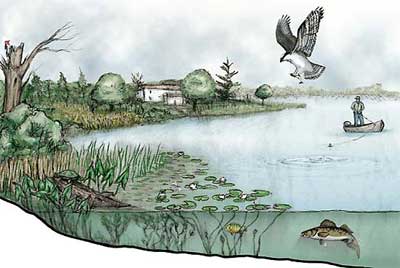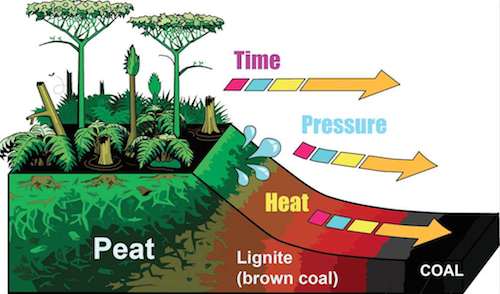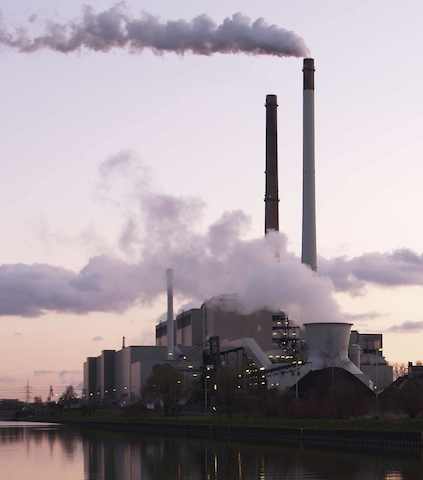Click for the student learning guide that accompanies this module.
1. Introduction: Ecosystems and Biogeochemical Cycles
In previous tutorials, we’ve seen how photosynthesis moves carbon from a gaseous form in the air (carbon dioxide) to a solid form in carbohydrates. During cellular respiration, the carbon in carbohydrate is combined with oxygen to become, once again, carbon dioxide. This exchange of carbon between photosynthesis and respiration is the essence of the carbon cycle, and it’s been going on for billions of years.

The cycling of elements like carbon is a key feature of any ecosystem. An ecosystem consists of the living community of organisms in an area, plus the non-living components of the environment (the air, the soil, the water, and so on). The living parts (or formerly living parts) of an ecosystem are called biotic components. The non-living parts are referred to as abiotic components.
The diagram on your right shows a lakeside ecosystem. Study it for a moment, and then classify the following parts of this ecosystem as either biotic or abiotic.
[qwiz qrecord_id=”sciencemusicvideosMeister1961-Biotic or Abiotic Table (Ecosystems)”]
[h]Interactive Table: Biotic v. Abiotic Ecosystem Components.
[q labels = “top”]
| Ecosystem Component | Biotic or Abiotic? |
| atmospheric gases (nitrogen, oxygen, etc) | ____________ |
| birds | ____________ |
| decomposers (bacteria and fungi) | ____________ |
| energy from the sun | ____________ |
| fish | ____________ |
| grasses | ____________ |
| water lillies | ____________ |
| sand on the lake bottom | ____________ |
| trees | ____________ |
| water | ____________ |
| rocks | ____________ |
[l]abiotic
[fx] No. Please try again.
[f*] Good!
[l]biotic
[fx] No. Please try again.
[f*] Great!
[/qwiz]
The movement of carbon from an abiotic form in the air, to living matter, and then back to the air is an example of a biogeochemical cycle. Let’s take this word apart:
- The prefix “bio” relates to life.
- “Geo” relates to the Earth.
- “Chemical” refers to the elements or compounds that we’re concerned with.
As an example of a biogeochemical cycle, let’s study the carbon cycle.
2. Vocabulary Check
[qdeck random = “true” qrecord_id=”sciencemusicvideosMeister1961-Ecosystems Flashcards 1″]
[h]Flashcards: Ecology and Biogeochemical Cycles Vocabulary
[!!!!]card 1 [/!!!!]
[q]__________ components of ecosystems are not alive.
[textentry]
[a]Abiotic components of ecosystems are not alive.
[!!!!]card 12 [/!!!!]
[q]Abiotic components of ecosystems are not ______.
[textentry]
[a]Abiotic components of ecosystems are not alive.
[!!!!]card 3 [/!!!!]
[q]In ____________ cycles, elements or compounds cycle between living organisms and the non-living environment.
[textentry]
[a]In biogeochemical cycles, elements or compounds cycle between living organisms and the non-living environment.
[!!!!]card 4 [/!!!!]
[q]_________ components of an ecosystem are (or were) alive.
[textentry]
[a]Biotic components of an ecosystem are (or were) alive.
[!!!!]card 5 [/!!!!]
[q]Biotic components of an ecosystem are (or were) ______.
[textentry]
[a]Biotic components of an ecosystem are (or were) alive.
[!!!!]card 6 [/!!!!]
[q]An _________ consists of the living community of organisms in an area, plus the non-living components of the environment
[textentry]
[a]An ecosystem consists of the living community of organisms in an area, plus the non-living components of the environment.
[!!!!]card 7 [/!!!!]
[q]_________ moves carbon from a gaseous state in the air and makes it into solid carbohydrate.
[textentry]
[a]Photosynthesis moves carbon from a gaseous state in the air and makes it into solid carbohydrate.
[!!!!]card 8 [/!!!!]
[q]Carbohydrates are broken down for energy, oxygen is consumed, and carbon dioxide and water are released during _________ __________.
[textentry]
[a]Carbohydrates are broken down for energy, oxygen is consumed, and carbon dioxide and water are released during cellular respiration.
[/qdeck]
3. The Basic Carbon Cycle: Producers, Consumers, Respiration, and Photosynthesis
Carbon exists in a gaseous form as carbon dioxide in the atmosphere. Through photosynthesis, carbon dioxide gets pulled into plants, combined with water, and transformed into carbohydrate. This process is called carbon fixation. In the diagram below, find the arrow on the upper right that says “photosynthesis” and you’ll see carbon being transformed from a gas (carbon dioxide) to solid carbohydrate (the leaves, wood, and other parts of the tree).
.jpg)
Plants are known as producers because they’re the organisms that produce carbohydrate, the chemical energy that fuels both plants and animals. Once plants make carbohydrates, a few things can happen. One is that plants can use this chemical energy for their own purposes. Plants, in other words, will perform cellular respiration. As they do, they’ll convert carbohydrate back into carbon dioxide and water. This will release carbon dioxide back into the atmosphere.
Another thing that can happen is that animals can consume the carbohydrate made by plants—which is why animals are ecological consumers. When they do, they’ll perform cellular respiration, returning carbon dioxide back to the atmosphere. Before going further, make sure that you can identify these flows of carbon in the diagram below.
[qwiz qrecord_id=”sciencemusicvideosMeister1961-Carbon Cycle 1 (Ecosystems)”]
[h]Interactive Diagram: Carbon Cycle 1
[q labels = “top”]
[l]atmosphere
[fx] No. Please try again.
[f*] Good!
[l]consumers
[fx] No. Please try again.
[f*] Excellent!
[l]photosynthesis
[fx] No. Please try again.
[f*] Excellent!
[l]producers
[fx] No, that’s not correct. Please try again.
[f*] Excellent!
[l]respiration
[fx] No, that’s not correct. Please try again.
[f*] Excellent!
[l]consumption
[fx] No. Please try again.
[f*] Correct!
[/qwiz]
4. Death and decomposition are also part of the carbon cycle
When plants and animals die, their bodies will be broken down by fungi and bacteria that act as decomposers. Decomposition also involves cellular respiration, meaning that the carbon in the bodies of dead plants and animals gets returned to the atmosphere as carbon dioxide.
Add these factors into the carbon cycle diagram below.
[qwiz qrecord_id=”sciencemusicvideosMeister1961-Carbon Cycle 2 (Ecosystems)”]
[h]Interactive Diagram: Carbon Cycle 2
[q labels = “top”]
[l]atmosphere
[fx] No. Please try again.
[f*] Good!
[l]consumers
[fx] No. Please try again.
[f*] Excellent!
[l]photosynthesis
[fx] No. Please try again.
[f*] Excellent!
[l]producers
[fx] No, that’s not correct. Please try again.
[f*] Excellent!
[l]respiration
[fx] No, that’s not correct. Please try again.
[f*] Excellent!
[l]consumption
[fx] No. Please try again.
[f*] Correct!
[l]decomposers
[fx] No. Please try again.
[f*] Good!
[l]death
[fx] No, that’s not correct. Please try again.
[f*] Good!
[/qwiz]
5. Fossil fuel formation, extraction, and combustion add more complexity to the carbon cycle

During the Earth’s long history, there have been a few periods when forests and algae grew at such a rate that decomposition couldn’t keep up with the accumulation of dead organic matter on the floor of forests or the sandy bottoms of oceans.
One of these period was the Carboniferous era, which occurred between 350 and 300 million years ago. During the Carboniferous, all of that carbohydrate accumulated into vast layers. The heat and pressure generated by the weight of these layers transformed this carbohydrate into fossil fuels: coal, petroleum (fuel oil), and natural gas. The diagram above and to the right focuses on coal, but the process is similar for all fossil fuels.

Though these fossil fuels were formed millions of years ago, they mostly lay undisturbed under the ground until the 1800s, when the Industrial Revolution began. Now, fossil fuels are our biggest energy source. Their extraction and processing are billion dollar industries. And combustion is now one of the biggest sources of carbon dioxide in the atmosphere.
As a chemical equation, combustion looks almost identical to respiration. In a car, for example, this combustion reaction occurs.
gasoline + oxygen → energy (heat) + carbon dioxide + water
This human-caused release of carbon is causing the amount of carbon dioxide in the atmosphere to rise. While carbon dioxide levels in the atmosphere were at about 280 parts per million before the industrial revolution, they recently surpassed 400 parts per million. Because carbon dioxide is a greenhouse gas, this is trapping heat in our atmosphere, increasing global temperatures.
Add the formation, extraction/processing, and combustion of fossil fuels to the carbon cycle diagram below.
[qwiz qrecord_id=”sciencemusicvideosMeister1961-Carbon Cycle 3 (Ecosystems)”]
[h]Interactive Diagram: Carbon Cycle 3
[q labels = “top”]
[l]atmosphere
[fx] No. Please try again.
[f*] Good!
[l]consumers
[fx] No. Please try again.
[f*] Excellent!
[l]photosynthesis
[fx] No. Please try again.
[f*] Excellent!
[l]producers
[fx] No, that’s not correct. Please try again.
[f*] Excellent!
[l]respiration
[fx] No, that’s not correct. Please try again.
[f*] Excellent!
[l]consumption
[fx] No. Please try again.
[f*] Correct!
[l]decomposers
[fx] No. Please try again.
[f*] Good!
[l]death
[fx] No, that’s not correct. Please try again.
[f*] Good!
[l]combustion
[fx] No, that’s not correct. Please try again.
[f*] Good!
[l]extraction/processing
[fx] No. Please try again.
[f*] Correct!
[l]fossil fuel formation
[fx] No. Please try again.
[f*] Good!
[l]fossil fuels (coal, oil natural gas)
[fx] No. Please try again.
[f*] Correct!
[l]factories/machines
[fx] No. Please try again.
[f*] Good!
[/qwiz]
6. Carbon Cycle: Music Video and Interactive Lyrics
That’s the Carbon Cycle. There are additional parts to the cycle: for example, carbon can be trapped in rocks, and then released in volcanoes after hundreds of millions of years. But that goes beyond our goals for right now. I’ve taken most of what you’ve read above, and put it into musical form in my Carbon Cycle song. If you’re listening to this in a classroom, please listen with headphones so you don’t disturb the students next to you.
[qwiz use_dataset=”SMV_Carbon Cycle Interactive Lyrics” dataset_intro=”false” qrecord_id=”sciencemusicvideosMeister1961-Carbon Cycle 4 (Interactive Lyrics: Ecosystems)”]
[h]Carbon Cycle: Interactive Lyrics
[i]
[/qwiz]
7. Carbon Cycle: Cumulative quiz
When you’re confident that you understand the material above, take the quiz below.
[qwiz random = “true” use_dataset=”SMV_Carbon Cyc le Cumulative Quiz” dataset_intro=”false” qrecord_id=”sciencemusicvideosMeister1961-Carbon Cycle Cumulative Quiz (Ecosystems)”]
[h]Quiz: Carbon Cycle, Cumulative Quiz
[i]
[x][restart]
[/qwiz]
Links
-
- Continue on to the next tutorial in the series, the Nitrogen Cycle.
